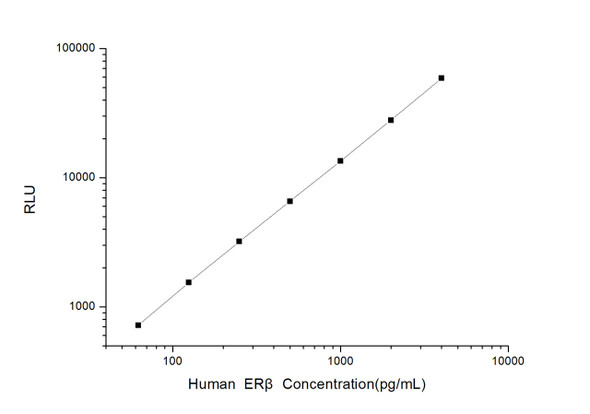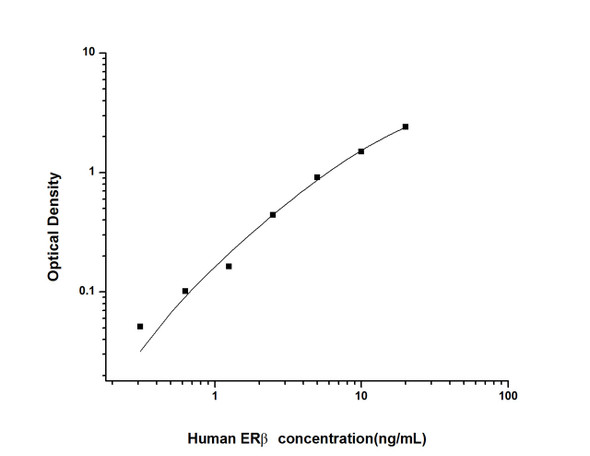Mouse Epigenetics and Nuclear Signaling ELISA Kits
Mouse ER beta (Estrogen Receptor Beta) CLIA Kit (MOES00256)
- SKU:
- MOES00256
- Product Type:
- ELISA Kit
- ELISA Type:
- CLIA Kit
- Size:
- 96 Assays
- Sensitivity:
- 37.5pg/mL
- Range:
- 62.5-4000pg/mL
- ELISA Type:
- Sandwich
- Synonyms:
- ESR2, ER-BETA, ESR-BETA, ESRB, ESTRB, Erb, NR3A2, Estrogen Receptor 2, nuclear receptor subfamily 3, group A, member 2
- Reactivity:
- Mouse
- Sample Type:
- Serum, plasma and other biological fluids
- Research Area:
- Epigenetics and Nuclear Signaling
Description
| Assay type: | Sandwich |
| Format: | 96T |
| Assay time: | 4.5h |
| Reactivity: | Mouse |
| Detection method: | Chemiluminescence |
| Detection range: | 62.50-4000 pg/mL |
| Sensitivity: | 37.50 pg/mL |
| Sample volume: | 100µL |
| Sample type: | Tissue homogenates,cell lysates and other biological fluids |
| Repeatability: | CV < 15% |
| Specificity: | This kit recognizes Mouse ER beta in samples. No significant cross-reactivity or interference between Mouse ER beta and analogues was observed. |
This kit uses Sandwich-CLIA as the method. The micro CLIA plate provided in this kit has been pre-coated with an antibody specific to Mouse ER beta. Standards or samples are added to the appropriate micro CLIA plate wells and combined with the specific antibody. Then a biotinylated detection antibody specific for Mouse ER beta and Avidin-Horseradish Peroxidase (HRP) conjugate are added to each micro plate well successively and incubated. Free components are washed away. The substrate solution is added to each well. Only those wells that contain Mouse ER beta, biotinylated detection antibody and Avidin-HRP conjugate will appear fluorescence. The Relative light unit (RLU) value is measured spectrophotometrically by the Chemiluminescence immunoassay analyzer. The RLU value is positively associated with the concentration of Mouse ER beta. The concentration of Mouse ER beta in the samples can be calculated by comparing the RLU of the samples to the standard curve.
| UniProt Protein Function: | ER-beta: a nuclear hormone receptor and transcription factor. Binds and activated by estrogen. Regulates gene expression and affects cellular proliferation and differentiation in target tissues. Binds estrogens with an affinity similar to that of ER-alpha, and activates expression of reporter genes containing estrogen response elements (ERE) in an estrogen-dependent manner. Eight alternatively-spliced isoforms have been described. Isoform beta-cx lacks ligand binding ability and has no or only very low ERE binding activity resulting in the loss of ligand-dependent transactivation ability. |
| UniProt Protein Details: | Protein type:Nuclear receptor; DNA-binding Cellular Component: neuron projection; mitochondrion; cell soma; perinuclear region of cytoplasm; cytoplasm; plasma membrane; perikaryon; nucleus; cilium Molecular Function:peroxisome proliferator activated receptor binding; ligand-dependent nuclear receptor activity; estrogen receptor activity; hormone binding; zinc ion binding; metal ion binding; estrogen response element binding; drug binding; steroid binding; protein binding; enzyme binding; DNA binding; sequence-specific DNA binding; steroid hormone receptor activity; lipid binding; transcription factor activity Biological Process: transcription from RNA polymerase II promoter; estrogen receptor signaling pathway; behavioral fear response; positive regulation of apoptosis; negative regulation of smooth muscle cell proliferation; induction of apoptosis by hormones; positive regulation of transcription, DNA-dependent; neuron migration; negative regulation of transcription from RNA polymerase II promoter; uterus development; negative regulation of cell proliferation; learning and/or memory; regulation of transcription, DNA-dependent; ovarian follicle development; positive regulation of epidermal growth factor receptor signaling pathway; regulation of neuron apoptosis; negative regulation of epithelial cell proliferation; steroid hormone receptor signaling pathway; transcription, DNA-dependent; vagina development; Sertoli cell proliferation; response to testosterone stimulus; regulation of cell proliferation; steroid hormone mediated signaling; positive regulation of transcription factor activity; positive regulation of transcription from RNA polymerase II promoter; brain development; negative regulation of behavior |
| UniProt Code: | O08537 |
| NCBI GenInfo Identifier: | 46877096 |
| NCBI Gene ID: | 13983 |
| NCBI Accession: | NP_997590. 1 |
| UniProt Secondary Accession: | O08537,O35635, O70519, Q8BG65, Q91Z86, B2RUC6, E9QKX7 |
| UniProt Related Accession: | O08537 |
| Molecular Weight: | 59,070 Da |
| NCBI Full Name: | estrogen receptor beta isoform 1 |
| NCBI Synonym Full Names: | estrogen receptor 2 (beta) |
| NCBI Official Symbol: | Esr2 |
| NCBI Official Synonym Symbols: | ER[b]; Estrb; ERbeta |
| NCBI Protein Information: | estrogen receptor beta; ER beta; ER-beta; oestrogen receptor beta; nuclear receptor subfamily 3 group A member 2 |
| UniProt Protein Name: | Estrogen receptor beta |
| UniProt Synonym Protein Names: | Nuclear receptor subfamily 3 group A member 2 |
| UniProt Gene Name: | Esr2 |
| UniProt Entry Name: | ESR2_MOUSE |
As the RLU values of the standard curve may vary according to the conditions of the actual assay performance (e. g. operator, pipetting technique, washing technique or temperature effects), the operator should establish a standard curve for each test. Typical standard curve and data is provided below for reference only.
| Concentration (pg/mL) | RLU | Average | Corrected |
| 4000 | 53325 64837 | 59081 | 59046 |
| 2000 | 26433 29285 | 27859 | 27824 |
| 1000 | 14393 12575 | 13484 | 13449 |
| 500 | 6507 6703 | 6605 | 6570 |
| 250 | 3419 3067 | 3243 | 3208 |
| 125 | 1705 1457 | 1581 | 1546 |
| 62.50 | 719 791 | 755 | 720 |
| 0 | 34 36 | 35 | -- |
Precision
Intra-assay Precision (Precision within an assay): 3 samples with low, mid range and high level Mouse ER beta were tested 20 times on one plate, respectively.
Inter-assay Precision (Precision between assays): 3 samples with low, mid range and high level Mouse ER beta were tested on 3 different plates, 20 replicates in each plate.
| Intra-assay Precision | Inter-assay Precision | |||||
| Sample | 1 | 2 | 3 | 1 | 2 | 3 |
| n | 20 | 20 | 20 | 20 | 20 | 20 |
| Mean (pg/mL) | 193.44 | 348.18 | 1679.62 | 200.28 | 324.69 | 1649.17 |
| Standard deviation | 18.67 | 35.83 | 187.11 | 24.41 | 32.60 | 179.92 |
| C V (%) | 9.65 | 10.29 | 11.14 | 12.19 | 10.04 | 10.91 |
Recovery
The recovery of Mouse ER beta spiked at three different levels in samples throughout the range of the assay was evaluated in various matrices.
| Sample Type | Range (%) | Average Recovery (%) |
| Serum (n=5) | 94-107 | 101 |
| EDTA plasma (n=5) | 98-110 | 104 |
| Cell culture media (n=5) | 102-116 | 108 |
Linearity
Samples were spiked with high concentrations of Mouse ER beta and diluted with Reference Standard & Sample Diluent to produce samples with values within the range of the assay.
| Serum (n=5) | EDTA plasma (n=5) | Cell culture media (n=5) | ||
| 1:2 | Range (%) | 96-107 | 85-101 | 95-113 |
| Average (%) | 101 | 92 | 103 | |
| 1:4 | Range (%) | 100-119 | 89-102 | 100-115 |
| Average (%) | 108 | 94 | 109 | |
| 1:8 | Range (%) | 98-113 | 89-106 | 85-96 |
| Average (%) | 104 | 97 | 91 | |
| 1:16 | Range (%) | 85-99 | 98-111 | 88-100 |
| Average (%) | 91 | 106 | 94 |
An unopened kit can be stored at 4°C for 1 month. If the kit is not used within 1 month, store the items separately according to the following conditions once the kit is received.
| Item | Specifications | Storage |
| Micro CLIA Plate(Dismountable) | 8 wells ×12 strips | -20°C, 6 months |
| Reference Standard | 2 vials | |
| Concentrated Biotinylated Detection Ab (100×) | 1 vial, 120 µL | |
| Concentrated HRP Conjugate (100×) | 1 vial, 120 µL | -20°C(shading light), 6 months |
| Reference Standard & Sample Diluent | 1 vial, 20 mL | 4°C, 6 months |
| Biotinylated Detection Ab Diluent | 1 vial, 14 mL | |
| HRP Conjugate Diluent | 1 vial, 14 mL | |
| Concentrated Wash Buffer (25×) | 1 vial, 30 mL | |
| Substrate Reagent A | 1 vial, 5 mL | 4°C (shading light) |
| Substrate Reagent B | 1 vial, 5 mL | 4°C (shading light) |
| Plate Sealer | 5 pieces | |
| Product Description | 1 copy | |
| Certificate of Analysis | 1 copy |
- Set standard, test sample and control (zero) wells on the pre-coated plate and record theirpositions. It is recommended to measure each standard and sample in duplicate. Note: addall solutions to the bottom of the plate wells while avoiding contact with the well walls. Ensuresolutions do not foam when adding to the wells.
- Aliquot 100µl of standard solutions into the standard wells.
- Add 100µl of Sample / Standard dilution buffer into the control (zero) well.
- Add 100µl of properly diluted sample (serum, plasma, tissue homogenates and otherbiological fluids. ) into test sample wells.
- Cover the plate with the sealer provided in the kit and incubate for 90 min at 37°C.
- Aspirate the liquid from each well, do not wash. Immediately add 100µL of BiotinylatedDetection Ab working solution to each well. Cover the plate with a plate seal and gently mix. Incubate for 1 hour at 37°C.
- Aspirate or decant the solution from the plate and add 350µL of wash buffer to each welland incubate for 1-2 minutes at room temperature. Aspirate the solution from each well andclap the plate on absorbent filter paper to dry. Repeat this process 3 times. Note: a microplatewasher can be used in this step and other wash steps.
- Add 100µL of HRP Conjugate working solution to each well. Cover with a plate seal andincubate for 30 min at 37°C.
- Aspirate or decant the solution from each well. Repeat the wash process for five times asconducted in step 7.
- Add 100µL of Substrate mixture solution to each well. Cover with a new plate seal andincubate for no more than 5 min at 37°C. Protect the plate from light.
- Determine the RLU value of each well immediately.






